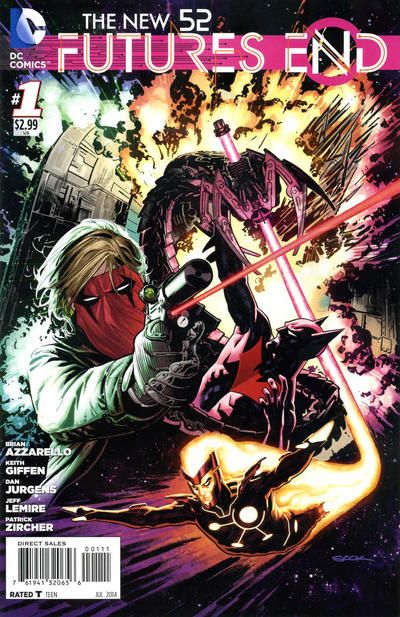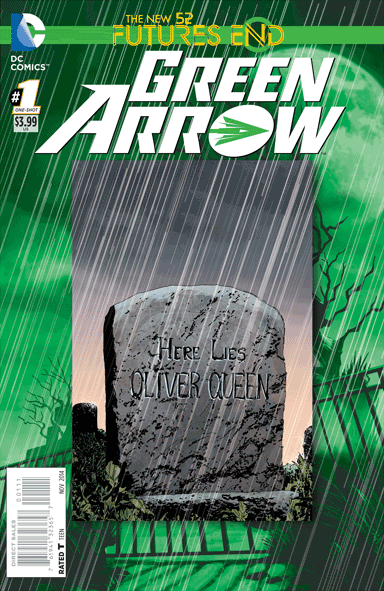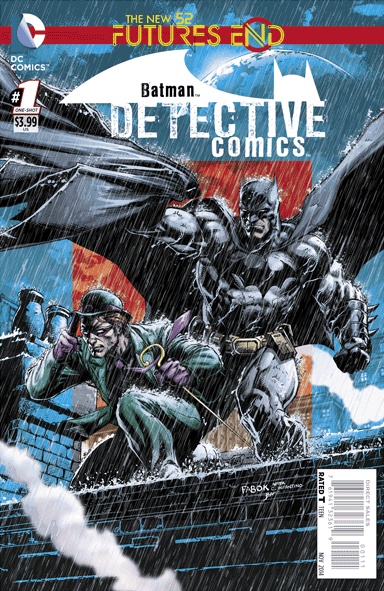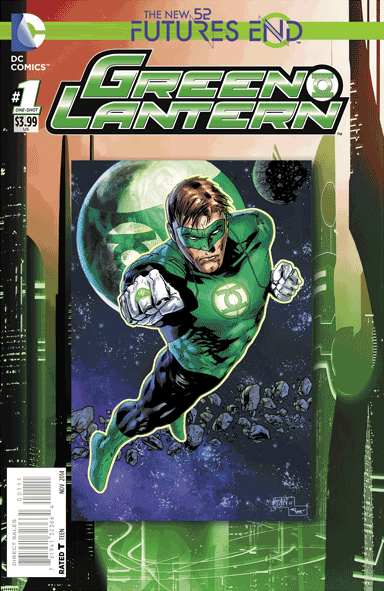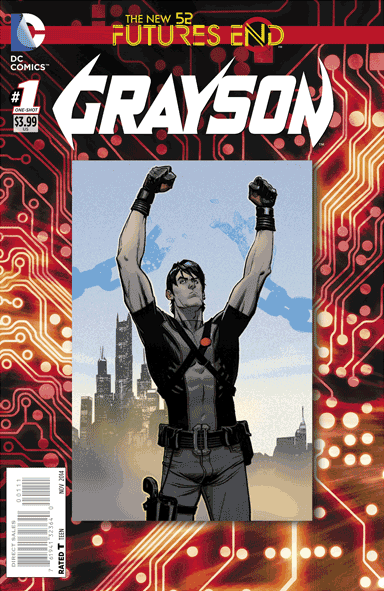In the near future, some sort of sentient operating system has awoken and taken over the world, transforming its inhabitants into cyborgs that then either kill or assimilate the rest of the population. To try to prevent this apocalyptic nightmare, Batman Bruce Wayne sends Batman Terry McGinnis into the past to stop that operating system from being created.
I know parts of that plot might sound familiar, but notice the presence of Batmen in it, so obviously I am describing The New 52: Futures End, DC Comics' weekly series set five year in the future, where McGinnis is trying to alter his past to save his future.
I wonder if DC could send someone back in time, whether they would have altered the storyline of Futures End a bit. It's always difficult to tell exactly how well a particular series is selling — in part because of the insane way the direct market sells comics, in part because publishers don't typically release numbers — but one expects DC might have had higher hopes for Futures End, given that this year's theme month of September is devoted entirely to tie-ins to the storyline, as the company has suspended much of its New 52 line and replaced it with 52 42 Futures End one-shots.
I'm still reading Futures End, so it's obviously not that bad. There certainly have been worse weekly DC series (of course, after you publish something as terrible as Countdown, it's hard to go anywhere but up, you know?), but the format seems a little rigid, and extremely easy for even the most loyal followers of particular characters to sit out. See, Futures End is set five years into a future that will never actually come to pass, meaning none of these one-shots — which are a little like the 2006 "One Year Later" issues, except they don't actually set up new directions, and a little like 1998's #1,000,000 issues, except much less ambitious— ultimately matters in the context of the ongoing series they're temporarily replacing.
On the other hand, they do have those weird 3D motion covers that seemed to sell OK last September.
Anyway, I expect if the DC Comics of September 2014 could send its time-traveling Batman back to spring 2013 or so, it would have him warn them to set Futures End in the present DC Universe to ensure higher sales. The alternate-future setting does give the writers — Brian Azzarello, Jeff Lemire, Dan Jurgens and Keith Giffen — plenty of freedom, but because so much of their cast consists of characters not being used much anywhere else, it wouldn't have been impossible to do so, just a little trickier. At least from what we've seen in the first 18 issues; maybe future ones will better justify the setting.
Meanwhile, I have been warned by a Batman from the future that I need to read and review as many of these one-shots as possible, but he refused to tell me why (just as he refused to give me any winning lottery numbers; he said he didn't even look into lottery numbers before traveling back into his past to give me this dire warning).
So, as I did last September with the Villains Month one-shots, I'm going to try and review every single one of these Futures End books ... that DC sends me. This week is was just five of the 10 releases, but, believe me, that's plenty.
If you haven't been reading Futures End, or at least following along with Tom Bondurant's weekly indexes, then here's the deal: Batman Beyond Terry McGinnis and a cyborg of Plastique traveled from 35 years from now back to five years from now; too late to stop Brother Eye's rise, but he's going to try to break into Mr. Terrific's TerrifiTech HQ to stop him from releasing his Brother Eye-powered uSpheres anyway.
Meanwhile, the world is reeling from some sort of extra-dimensional war that occurred somewhere between 2014 and 2019 that involved Earth 2 (as seen in the comic book Earth 2) and Apokolips; the former was apparently destroyed, flooding the DCU of 2019 with Earth 2 refugees.
Some heroes are missing, many heroes have changed, some have grown beards and many of those whose comics have been canceled have ongoing sub-plots.
All caught up? Good, then let's plunge into this week's stack of comics, which I will review in the order of worst (according to me) to best (again, according to me), noting to what degree they seem to tie in to the Futures End plot as it has so far been revealed.
Earth 2: Futures End #1
Written by Daniel H. Wilson, penciled by Eddy Barrows, inked by Eber Ferreira and colored by Pete Pantazis
This book is put in a rather awkward place by the premise, as the setting in the title is no longer extant in the "Five Years Later" setting we're told it occurs in. I'm assuming it takes place on Earth 1, or whatever we call the Earth that the rest of the New 52 is set on, but it's never explicitly stated, and Barrows draws and dresses lead character Michael "Mr. Terrific" Holt so differently from the one in Futures End that it's difficult to be sure.
Holt is one of the relatively few characters who's spent a great deal of time on both Earths, and is therefore as good a protagonist as any for this issue, particularly because he plays a key role in Futures End. The plot revolves around another character from the book, Terry Sloane, trying to get his hands on a New God weapon in Holt's possession. He's working with another character I never recognized and wasn't properly introduced to in the book; I think he's meant to be Earth 1's Sloane or ... I don't know. I don't read Earth 2.
Cover girl Red Tornado appears on one page, as does Earth 2's Jimmy Olsen. There's a Mother Box in it; that might be important, or it might not be. As far as I can tell, this seemed to be pretty skippable, but maybe those clues point to something in the future.
Barrows draws an organ flying out of someone's body as they die a gory death; there seems to be a decent subset of DC readers who like that sort of thing, based on the fact that I'm still reading Barrows-drawn comics with gory deaths in them so many years after his Teen Titans run.
Green Arrow: Futures End #1
Written by Jeff Lemire, illustrated by Andrea Sorrentino and colored by Marcelo Mailo
I suppose some of you would rate this book higher, declaring it one of the better of the one-shots. That's OK, I'm not here to judge ... you. However, I dislike Sorrentino's grotesque use of photo-reference and actual photographs: The backgrounds are photos manipulated by computer, the objects all appear to be photos, and the main characters look to be drawn from life, as if models donned homemade costumes in Sorrentino's studio, resulting in a Deathstroke who looks as if he might be wearing Snake Eyes' first mask.
This issue seems well-positioned to be important to Futures End, featuring as it does Green Arrow (who died in Futures End #1), Green Arrow II Emiko Queen, Deathstroke (both of whom have ongoing plotlines in Futures End) and one of the mysterious clues given to Lois Lane in Futures End #2. It's also written by Lemire, one of Futures End's four writers.
This issue actually fits quite seamlessly in with Futures End #18, which shipped this week, as it offers a sort of behind-the-scenes complement to the events of the weekly, with its big doings for the Green Arrow characters.
Of the five I read, this one seemed to be the most closely tied to the series it spins out of.
Detective Comics: Futures End #1
Written by Brian Buccellato, illustrated by Scott Hepburn, Cliff Richards and Fabrizio Fiorentino, and colored by Buccellato and Lee Loughridge
Batman Bruce Wayne has been almost entirely absent from the pages of Futures End, save for a cameo or two to let us know he's still around in 2019, so it's interesting to get a look at the character as he's supposed to exist five years from now.
He has a redesigned costume, aspects of which change from artist to artist (and this 20-page story has three of 'em) and some higher-tech gadgets, including a rocket-sled borrowed from the Green Goblin, but Batman seems otherwise unchanged ... at least until the climax.
The story here is that the Calendar Man, recently introduced in Detective Comics Annual #3 as an enormous, bald thug and child-abuser who apparently assumed his identity after Batman beat him up and told him to "buy a damn calendar." In the five years since, he still doesn't adopt a costume or the tattoos Tim Sale gave him in The Long Halloween and Dark Victory; he just has some sort of grid-like scoring over his face. Perhaps that's meant to be scars that evoke the grids of a calendar, but they're drawn diagonally, and thus more diamond-shaped than square.
He has somehow taken over Arkham Island, which the Riddler designed with impenetrable security so that no one can sneak up on Calendar Man and the other inmates. To stop him, and save the city and hostages, Batman must team up with the Riddler to break in and confront Calendar Man.
It's a fairly simple done-in-one, rather screwed up by the incongruous artwork, which contradicts minor facts as well as styles, with an extremely strange ending. If this weren't a possible future, it would seem like a hideous mischaracterization of Batman (especially if you also read this week's Grayson one-shot), but then, we know that in 35 years Batman will have become so desperate as to have changed a moral tenet of his, so maybe Buccellato is offering a step in that evolution.
Green Lantern: Futures End #1
Written by Robert Venditti, illustrated by Martin Coccolo and Aaron Lopresti, and colored by Alex Sinclair
Hal Jordan and the other Green Lanterns have been virtually absent from Futures End (John Stewart appeared as one of many old-man superheroes being assimilated by cyborgs in the zero issue). So, as with the Detective one-shot, this was interesting from a, "Hey, what's Hal Jordan been up to?" perspective.
Apparently, he missed the big war — just as he missed Forever Evil — because he was busy off in space, doing space-stuff, and he feels so guilty about it that he's in some sort of semi-retirement. However, when his father's ghost shows up to warn him that Krona is the new Black Hand and is raising an army of Black Lanterns, Hal puts his ring back on and teams up with Relic (introduced in the first storyline of the post-Geoff Johns Green Lantern line) to save the day.
It has next to nothing to do with Futures End, of course, but it functions quite nicely as a theoretical last Hal Jordan story, giving him a big, heroic death, cementing (almost literally) his place as a mythical hero of the DC Universe, and even resolving core tensions and motivations in the character that Johns introduced.
So Venditti does a pretty great job, particularly given the limitations the premise forced upon him, and what I'm assuming was little lead time, as this is yet another 20-page book that required more than one artist to complete. At least Coccolo and Lopresti work in similar enough styles that the transition is smooth, if not completely seamless.
Grayson: Futures End #1
Written by Tom King and Tim Seeley, illustrated by Stephen Mooney and colored by
Jeromy Cox
This issue was actually quite a surprise, perhaps because I was expecting so little. Grayson just started, so it's sort of unfair to saddle the book with a one-shot set five years in the future, but King and Seeley pull off a remarkable script.
It's a pretty gimmicky one, but what might at first seem like a showy stunt by someone who re-watched Memento the night before sitting down to write begins to work in increasingly interesting ways. That this is a story set five years in the future makes the unusual structure perhaps even more compelling, as the narrative time-travels about 10 years.
The issue begins, as all of these do, "five years from now." Apparently Spyral agents Dick Grayson and Helena Bertinelli joined forces with Future Russia (governed by President KGBeast, in a rather amusing jab at Russia's current president) to fight off the invading Parademons or whatever (this is the first book I've read that actually shows scenes set during the the constantly, but vaguely, mentioned war).
Grayson is dressed in a costume that's basically the one worn by Red Star when he was introduced in Teen Titans. Bertinelli continues to wear that weird Huntress top, only with a big red star slapped in the middle of the white cross pattern.
Anyway, on the first page, she's hanging Grayson to death. So I guess that answers the question of where Dick has been during the events of Futures End. The next page opens with the caption "Earlier," and features four panels that occurred before Dick's hanging. The next page features another "Earlier" caption, and depicts a scene before that. And so on, with ever page a scene set before the one you just read; the writers gradually get cute with dialogue in one scene explained by the page that follows.
And they go pretty far back, to when Dick was still Nightwing, back to when he was Robin, back to before he was Robin. Along the way, the writers do a fine job of characterizing Dick, Batman and Bertinelli and their various approaches to the taking of a life. They also construct a solid comic, the sort a reader can appreciate for its crafstmanship, regardless of any affection for the characters, or the story's importance to its purported tie-in.
There's an amusing Wertham antenna-tickling insight offered as to what Dick Grayson is looking for in a woman, and also one of the more complicated fart jokes I've encountered in a superhero comic.
So far, this looks like the Futures End one-shot to beat, but then, we do have three more Wednesdays worth of books to read.


